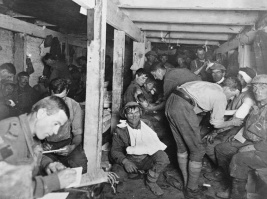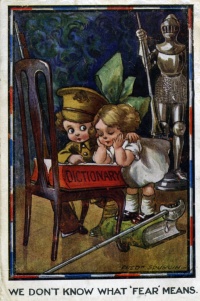Introduction↑
If asked which emotion governed the combat experience of soldiers in the First World War, most would probably name fear. But this commonsensical response raises the question: how can we know fear historically? Do letters and diaries, memoirs and official histories written during and shortly after the war not emphasize bravery? And even if these sources are dismissed as unauthentic because of a hegemonic culture of heroism, a certain brand of masculinity, and the attendant censorship and self-censorship, can we ever know what soldiers really felt?
Questions such as these are inescapable in the history of First World War emotions. Fear is considered visceral and deeply rooted in the evolutionary past, possessing a survival function (the “fight-or-flight response”). Since fear is deemed so basic and corporeal, it does not appear to lend itself easily to signification, e.g. through first-person sources in the First World War.
Because it is up against this folk understanding, and because of the premium the disciplinary conventions of history place on difference and specificity, any historical account of fear will, then, perforce, stress what is constructed rather than universal. Specificity is precisely what historians have been uncovering since the fin-de-millennium “emotional turn”.
One of the first findings is that fear rarely surfaces in accounts of wars before the mid- to late 19th century. Where it does surface, it is as a moral construct associated with notions of chivalry and as caused either by forces located outside the soldier, such as demons, or by personal character. This changed over the course of the 19th century for a number of reasons. First, the nature of warfare itself changed; an open battlefield in the Napoleonic Wars, for instance, forced soldiers into one-on-one combat, controlled by notions of honor, whereas in a trench on the Somme the option of overcoming fear by an honorable bayonet attack of - or, forward flight towards - the enemy soldier was absent. What is more, the very source of danger (where does the shell arrive from?) was difficult to locate. Second, in the latter half of the 19th century, military psychiatry came into being and with it a medical discourse of trauma that pivoted on fear and potentially made this emotion acceptable as pathogenic, and symptomatic, of such disease entities as shell shock. By the time of the First World War, a whole culture of anxiety, nervousness and fear had developed in many European societies.
Sources and Histories↑
“Bottom-up” first-person sources of the First World War, then, are awash with fear. Despite prevailing notions of masculine bravery, soldiers’ letters, diaries, and memoirs described the fear experience - associated with “baptism by fire”, different kinds of weaponry (including gas and air bombs), panicking or retreating units, and other feelings such as hatred, revenge, and shame. They described variable fear objects - being perceived as a coward by one’s closest comrades, the enemy, and death itself. They detailed the sensory experience of fear-inducing stimuli (e.g. the sounds of a bursting shell) and the somatic aspects of lived fear. They fell back on rank-related and ethnic stereotypes - the constitutionally fearless officer, the “cowardly Jew”. They recounted what might be termed coping strategies: battle cries, singing, cursing, humor, religion, superstition, smoking, alcohol.
Fear is similarly prominent in sources generated by civilians. Fear about loved ones at the front, fear of air raids, fear associated with war-related migration, hunger, and violence all made it onto the pages of ego-documents.
“Top-down” sources, such as military tactics, operational art, infantry regulations regarding the drill of recruits, or military statutes on cowardice and desertion are also full of fear, if in a more instrumentalist key. There, fear figures as an unruly emotion that endangers a soldier’s functioning. It is an object to be managed and ultimately overcome. For example, Mikhail Dragomirov (1830-1905), a Russian military theorist who was widely read across Europe, created what might be called a doctrine of controlled berserkerdom that revolved around fear. Dragomirov started from an axiomatic assumption about human nature: “the willingness to suffer and to die, that is, self-sacrifice”, was universal.[1] Unlike western soldiers, whom Dragomirov considered contaminated by decadent modernity, the Russian soldier was characterized by “a feeling of duty toward tsar and fatherland, a feeling that goes as far as self-denial”.[2] Self-denial in Dragomirov’s scheme constituted the antipode to self-preservation. The key to the victory of self-denial over self-preservation was drill, especially the training of obedience. The most effective antidote to fear, in other words, was practice and routine.
Dragomirov believed that the Russian army differed from western armies in its emphasis on morale instead of military technology, and that the Russian soldier differed from the western soldier in his ability to unleash and reign in his aggressions without using modern fire weapons. At bottom, we have here an attempt to resuscitate the pre-modern immediacy of face-to-face warfare. Paradoxically, Dragomirov’s doctrine was based on an image of self that stemmed from the Enlightenment and modernity: only an autonomous, rational subject can, on command, start and stop himself from going berserk.
Many nations generated similar collective emotional auto-stereotypes instantiated in a purportedly singular brand of morale. Thus, theorizing about soldierly élan in World War One France had a lot in common with Dragomirov’s writings. And all armies wrestled with the question of how realistic, how fear-inducing drill exercises ought to be designed. There were cases where armies erred on the side of realism and traumatized recruits before they ever saw combat.
Military Psychiatry↑
Before the First World War, many societies exhibited a general anxiety, which manifested itself in sociomedical discourses of neurasthenia, hysteria, etc. Once the war began, all parties deployed military psychiatrists. The diagnoses, etiologies, and therapies of these psychiatrists centered on fear - this becomes clear when the shell shock literature is reexamined through an emotional lens: fear is, as it were, hidden in plain view. Psychiatrists differed on whether the shaking and contorted bodies, the mutism and blindness, were a consequence of the terrifying nature of industrial warfare or of predispositions, acquired or inherited. This debate was always bound up with concrete financial issues: if shell shock was caused by the war, the state would have to pay veteran pensions, if not, it was absolved. Generally speaking, British, French and Russian psychiatrists tended towards the former position whereas Austrian, German and Italian psychiatrists gravitated towards the latter. The reasons for this are complex but include such factors as the position of psychiatrists vis-à-vis the state. Russian doctors, for instance, were a classical profession boosted during Alexander II, Emperor of Russia’s (1818-1881) reform era. They saw themselves cheated out of political participation by the tsarist autocracy just like the peasant soldiers they treated - hence their greater empathy for the soldiers. Treatments included hypnosis and psychotherapy, but also methods predicated on combatting fear with fear: in Germany, for example, faradization (electric shock) was sometimes practiced.
The Second World War was very different in its formation of fear. In the Red Army, for example, military psychiatry had largely been liquidated during the 1930s. A much more repressive paradigm reigned, in which soldiers were threatened with blocking detachments, putting them in a Catch-22 situation: if they ran forward towards the enemy, they were fired at, if they panicked and retreated towards their own troops, they were fired at. The success of this kind of repressive fear management, including that of the Wehrmacht, disturbed western Allied military theorists and psychiatrists, among whom psychoanalytically inspired thought had made inroads. Thus, the First World War remains unique in its confluence of attempts among all warring parties to manage soldierly fear and to diagnose/treat fear-induced psychological breakdowns among soldiers.
Jan Plamper, Goldsmiths, University of London
Section Editor: Alexandre Lafon
Notes
- ↑ Dragomirow, Michail Iwanowitsch: Ausbildung und Erziehung, in: Dragomirow, Michail Iwanowitsch: Gesammelte Aufsätze. Neue Folge, Hannover 1891, p. 19.
- ↑ Dragomirov, Michail Iwanowitsch: Podgotovka voisk v mirnoe vremia (vospitanie i obrazovanie) [The Preparation of Troops in Peacetime (Training and Education)], in: Dragomirov, Michail Iwanowitsch (ed.): Izbrannye trudy. Voprosy vospitaniia i obucheniia voisk [Selected Works. Issues of the Training and Teaching of Troops], Moscow 1956, p. 625.
Selected Bibliography
- Bourke, Joanna: An intimate history of killing. Face-to-face killing in twentieth-century warfare, New York 1999: Basic Books.
- Micale, Mark S. / Lerner, Paul Frederick (eds.): Traumatic pasts. History, psychiatry, and trauma in the modern age, 1870-1930, Cambridge; New York 2001: Cambridge University Press.
- Michl, Susanne; Plamper, Jan: Soldatische Angst im Ersten Weltkrieg. Die Karriere eines Gefühls in der Kriegspsychiatrie Deutschlands, Frankreichs und Russlands, in: Geschichte und Gesellschaft 35/2, 2009, pp. 209-248.
- Plamper, Jan: Fear. Soldiers and emotion in early twentieth-century Russian military psychology, in: Slavic Review 68/2, 2009, pp. 259-283.
- Roper, Michael: The secret battle. Emotional survival in the Great War, Manchester; New York 2009: Manchester University Press.
- Wilcox, Vanda: 'Weeping tears of blood'. Exploring Italian soldiers' emotions in the First World War, in: Modern Italy 17/2, 2012, pp. 171-184.









